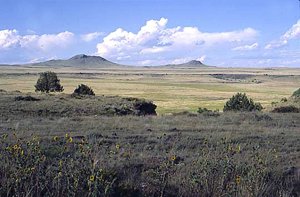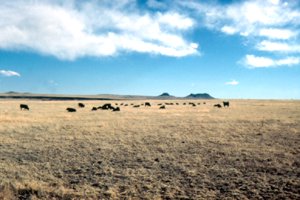  |
        |
|
  |
Wednesday, March 13, 2013 |
HOME / VISIT / Rabbit Ear Mountain |
  |
|
|
|
|
|
 |
|
|
The first caravan on it’s way from the Missouri River to Santa Fe learned the name of this mountain, OREJAS de CONEJOS (Rabbit Ears) from the Indians. It is believed that two great battles were fought here more than two hundred years ago. History tells that an expedition left Santa Fe and headed for the OREJAS de CONEJOS to meet the Comanches in battle in order to get them to release the Spanish prisoners. As the Spaniards knew this mountain by name, it must have been named before this date for the great Cheyenne Chief, Orejo de Conejos who was killed in battle and buried on top of the mountain that bears his name.
The old Spanish-American settlers in this country tell that his father’s father told him about the great battle of Rabbit Ears and the treaty made between the Comanches and Spaniards to cease fighting.
Amade Chaves, first public school superintendent of New Mexico in a monograph published by the Historical Society of New Mexico in 1905 describes the defeat of the Comanches in 1717; probably the bloodiest slaughter of Indians in western history.
Representatives of all parts of the province met in Santa Fe and organized a volunteer army. Don Juan de Padilla, Carlos Fernandez, and Padro Pino were chosen to command the army and within a short time, 500 young men armed, mounted, and with pack mules had been assembled for the expedition. They carried firearms, machetes, lances, and bows and arrows.
The army camped the first night at the Pueblo of Pecos and then moved by way of Anton Chico to the plains in what is now North-western Texas. Here they learned that the Comanches were camped a few leagues ahead, and made preparations to attack at daylight. They charged the teepee camp of the Comanches killing hundreds and taking 700 prisoners. The Spanish captives were liberated. So severe was the punishment of the Spanish punitive expedition that the Comanches never again went on the warpath against the Spaniards.
Whenever the young bucks wanted to start a war against the Spaniards, the old men would take them to "Las Orejas de Conejo" and show them the bones and skulls and tell them of the famous fight. |

 |
|
|
|
 |
 |
|
|
|
| |